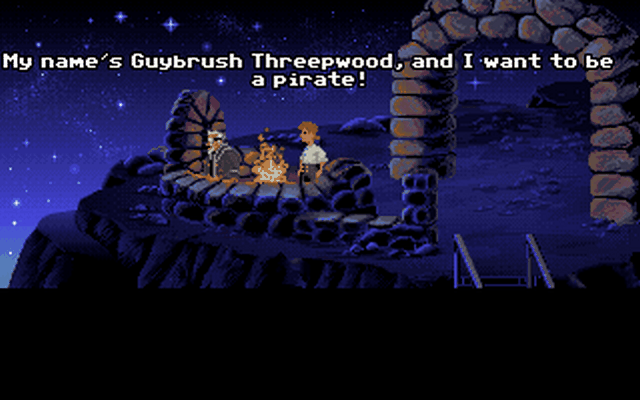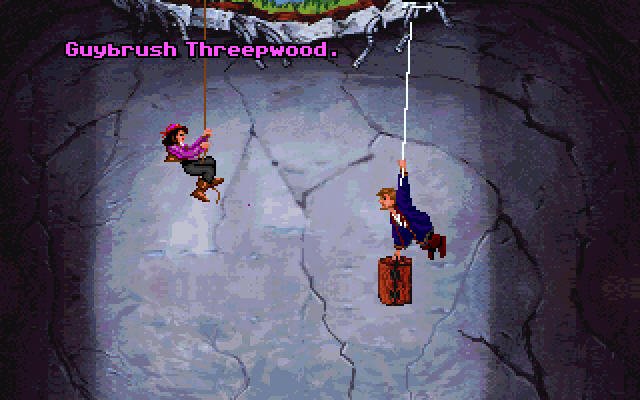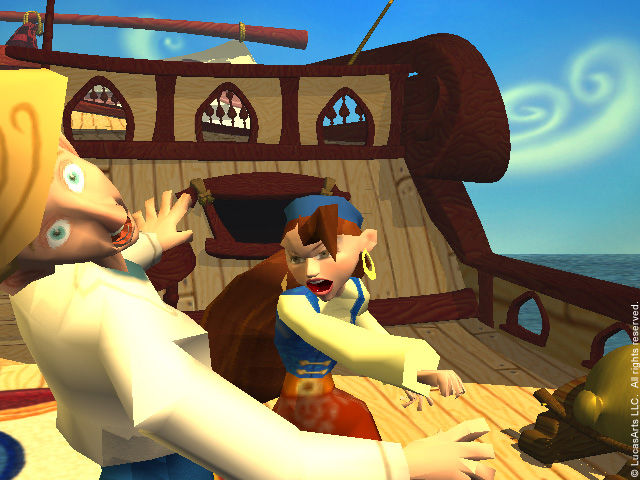A look back on: Monkey Island
Lucasarts used to do more than just release multiple Star Wars games year after year. That was twenty years ago. They had a game division which made a lot of classic adventure games that had nothing to do with Star Wars. I always thought the term “adventure” wasn’t all that fitting, that brings to mind more platforming elements, but I guess it sounds better than “plot-driven puzzle games.” They produced many classic titles, such as “Maniac Mansion”, ‘Grim Fandango” and “Sam & Max Hit the Road”, all of which had memorable characters, hilarious dialogue and brain-scratching puzzles. The genre died out in the mid to late nineties, but fans have always wanted more.
In the past few years, they’ve had something of a revival, especially by the company Telltale Games who have been releasing adventure games in an episodic format. They started getting major attention when they released two new seasons of Sam and Max two years ago and continued on with other games like “Strong Bad’s Cool Game for Attractive People” based on the characters on Homestarrunner.com and “Wallace and Gromit’s Grand Adventure” based on the famous duo of the same name. Recently, it was announced they would be releasing episodes for one of my favorite series next month: “Monkey Island”.
After squealing like a little girl in excitement, I figured it might be a good idea to go back and play through all four games in the series. I wanted to make sure I wasn’t looking through rose-colored glasses when looking back on these games, so I could see how they held up today in a world of advanced graphics.
Before I get into the games themselves, I’m going to give a brief explanation of the overall plot so I don’t have to repeat it four times. The games all star Guybrush Threepwood, an oddly named man who starts out on a journey to become a pirate, for no stated reason. Along the way he meets Governor Elaine Marley, who he falls in love with almost instantly, and like any couple, they have their share of problems. The biggest problem being that an undead pirate by the name of LeChuck is in love with her too. LeChuck loved Elaine when he was alive, but since she did not reciprocate, he died of a broken heart. So now he keeps coming back from the dead as a ghost/zombie/demon, depending on the game, looking to kill Guybrush to get him out the way, and to kill Elaine so he can make her undead and they can spend eternity together.
With that out of the way, let’s take a look at the games themselves.
The Secret of Monkey Island (1990)
Within the first minute of booting this game back up, a lot of memories rushed back. The opening theme is the start of a great soundtrack that fits the Caribbean setting of the game. A lot of people say this theme is one of the best opening themes ever, and I am inclined to agree. It’s later done by an orchestra, but I’ll always love the MIDI version.
The game itself still holds up every bit as well today as it did twenty years ago. The plot is simple, Guybrush starts out wanting to be a pirate, sets off to prove himself, falls in love in the process and must defeat the ghost pirate LeChuck to save Elaine in the end. While not the most original work, it is a fun story with a lot of great dialogue along the way.
As for the puzzles, there were one or two that stumped me, and their solution usually involved puns. God do I hate puns. If you pay attention to what everyone says, there are generally clues to what items you need to get or use to pass a location. For the most part, they are clever and original; although a few can get repetitive–you figure out the solution, but still have to go through the motions.
For those that never played the original, Telltale Games is putting out a new version with updated graphics (you’ll have the option of switching between the new graphics and old graphics on the fly) and voice in the summer of 2009. No specific date is given yet, but it will be available for the PC and Xbox live. I would highly recommend downloading it when it comes out.

It begins with a simple sentence
Monkey Island 2: LeChuck’s Revenge (1991)
One year later the sequel was out. The game basically has the same graphic style and interface. Guybrush’s sprite now has him looking a little older with a beard and he wears a blue coat.
Guybrush is now a pirate, and everyone is tired of hearing his one story of how he defeated LeChuck, so he sets off to find the treasure of Big Whoop. At the same time, LeChuck is resurrected as a zombie and seeks revenge. The plot is a little more involved this time, but the game ends on a very odd cliffhanger that comes out of nowhere.
The difficulty has been ramped up steeply though. The puzzles are more complex, usually requiring multiple actions to be solved. There is an option to play on easy mode, but even then, some of the solutions aren’t so obvious. As a whole, the game seems longer too. The main quest just felt like it took longer to get through than it did in the previous game, though it does this without overstaying its welcome.
This was the last game in the series that creator, Ron Gilbert, worked on. He was supposed to head a third, but never did. His third game was supposed to explain the cliffhanger in this one and finally reveal the secret of Monkey Island. Though he wasn’t involved in the next game, the plot did its best to wrap up that loose plotline (though I think they could have done it better), but did not reveal the secret.

Personally, I never cared for the beard; glad they got rid of it in later games.
The Curse of Monkey Island (1997)
Six years later, Lucasarts released their last game using the SCUMM engine (Script Creation Utility for Maniac Mansion, which all previous adventure games ran on). Instead of using sprites, the whole game is animated, looking more like a Saturday morning cartoon show, and includes cut scenes. I always felt this look was fitting to the game, as the plot itself has always been a little goofy, but fun.
Along with the graphics, the interface changed too. Your inventory and commands are no longer displayed along the bottom. Instead, right clicking the mouse will bring up your inventory and hovering over any object will bring up three commands: Look at, Use, or Talk. The simplified commands work much better in my opinion, in the previous games there were some commands used only once or twice.
The plot isn’t just about being a pirate this time. Guybrush accidentally proposes to Elaine with a ring that has a voodoo curse on it. Elaine is turned into a gold statue, and Guybrush is out to reverse the effects of the curse, while being hindered by LeChuck the demon.
This is also the first game to feature a full voice cast. Everyone was cast well too and fit their parts. Guybrush sounds young and a little naïve, LeChuck is what you’d expect from an undead pirate, and all the supporting cast play their roles well. The only voice that threw me off in the whole game was one Scottish pirate who was clearly played by the voice actor for Scrooge McDuck from Ducktales. He did a good job, but to me the voice will always be Scrooge.
Again, the option for an easy mode is given in this game, but I don’t think it’s needed. None of the puzzles are too frustrating, once in a while you may get stuck, but nothing going through your inventory and walking around certain locations studying the environment can’t solve.

Plus this game introduces Murray, the mighty demonic skull!
Escape from Monkey Island (2000)
One of Lucasarts last adventure games until recently, Escape from Monkey Island is a phoned-in attempt at a sequel. Everything is now in poorly modeled 3D (I know it was ten years ago, but still, there was better animation back then), and looks awkward. Whenever there is a pre-scripted event, it is not uncommon to see a character rigidly turn without animation, then go through the motion. Most of the time, they’ll go through the whole animation of something, and then go back to their starting animation, only to go back to the final frame seconds later. It’s all very glitchy and has an unfinished feel to it.
The plot is bizarre, even with a suspension of disbelief. Elaine and Guybrush have been on their honeymoon, and while gone, Elaine was declared dead. Being dead means the spot for governor is open and she has to run a campaign to get it back, and is running against a man named Charles L. Charles who is actually (surprise!) LeChuck, who can now switch between human/ghost/zombie/demon forms for no explained reason. At the same time, an Australian land developer is buying up all the land in the Caribbean and retraining pirates to be placid to make the whole place a resort that is safe for tourists. While the game made jokes and references to pop culture, it’s a little off-putting to have places like Starbuccaneers, and someone else trying to sell you time shares in the game. I’m not looking for complete historical accuracy here, but don’t go overboard.
The controls are absolutely terrible. The past three games were completely mouse-oriented, with options to use the keyboard for some actions. This game takes the controls from one of their previous games, Grim Fandango (which I would also recommend), but it feels broken. The keyboard is used for everything, including movement. It has the Resident Evil tank controls, where left and right turn your body, and back and forward move you around. This wouldn’t be so bad, except it’s not clearly labeled where you can and can’t go, so you’ll find yourself hitting invisible walls or accidentally turning around when you didn’t need to (I got stuck on a puzzle because I didn’t realize that there was a whole other section to an island I was on). Interacting with items can be a pain too; I missed a few things because you need to be facing directly at an object to see it. The camera doesn’t help in this respect either, as much of the time you’ll find it far away and you will have trouble figuring out which direction you’re facing.
The puzzles in this game are hard for all the wrong reasons. Most of the time, solutions aren’t hinted at like they were in previous games, and it’s never explained what you need to do beyond some very broad goals. You’re just interacting and using objects wherever you can for no explained reason, and hoping for the best. The controls don’t help in this matter at all, especially since a lot of puzzles require specific timing. The final puzzle was the most frustrating for me, as there are no hints as to what you have to actually do. The whole thing feels like a poorly made fan game, especially when considering it reuses some puzzles from the first game.

It doesn’t get any better looking
After playing through all of these, I can safely say that the first three games hold up just as well as they did the day they were released. They’re worth tracking down and downloading the SCUMM client (found at http://www.scummvm.org/) to get them to run. The fourth is only worth playing if you’re a fan of the series, as it did not age well at all. It lacks a charm the other three have, and proves that updated graphics do not make for a better game.
As for me, I am eagerly awaiting July 7th, which is when the first episode of Tales of Monkey Island comes out, which I will give a full review of once all five episodes are complete, assuming I don’t get stuck on a puzzle somewhere along the line.
No trackbacks yet.